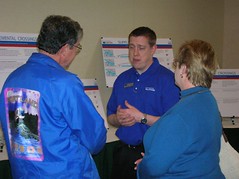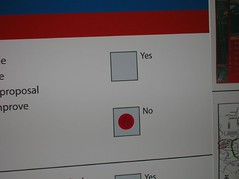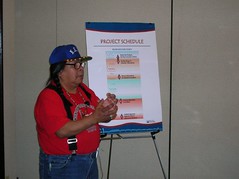Last night I attended the Columbia River Crossing open house at Hayden Island (one was also held the prior evening in Vancouver).
The key output of this phase of public comment is to influence the project components that go forward in the Environmental Impact Statement process.
There are actually 23 separate crossing elements and 14 transit elements under consideration. Some have been recommended by the staff, others not.

I still think this project has cool shirts. |

Thumbs up or down on the staff recommendation for possible project elements. |

Columbia River creation myth featuring Muskrat and Coyote. |
Last night I attended the Columbia River Crossing open house at Hayden Island (one was also held the prior evening in Vancouver).
The key output of this phase of public comment is to influence the project components that go forward in the Environmental Impact Statement process.
There are actually 23 separate crossing elements and 14 transit elements under consideration. Some have been recommended by the staff, others not.
I propose to use this blog as an extension of the public comment process. Starting this weekend and over the course of the next week or so, I will post each of the 37 project elements (probably putting them in some logical groups), along with the staff scoring, and we’ll discuss them.
At the end of the process, I’ll submit all of the discussion and comments to be part of the public input for the process.
For those of you who want to get a head start, the various elements are described in the screening report (PDF, 3.3M) from the March 22nd task force meeting.
Comments have been closed and will be submitted to the project public record. If you have additional thoughts, please comment on the open thread for this purpose.
9 responses to “Theme Week Coming Up: The Columbia Crossing”
I was up at the CRC Open House at the Red Lion last night and noted that my old neighbor here on Swan Island, Shenanigan’s, is now in that hotel.
I drove via MLK and of course had to get on the freeway to get to Hayden Island. So I asked or commented…”I should be able to drive up MLK and have a drink at Shenanigans without having to get on an Interstate freeway! Where’s the arterial bridge?” Remember 1/3 of I-5 trips are local.
Two options that have arterial pieces…Arterial Bridge with lightrail plus freeway upgrades and Short Tunnel with retension of one or both existing bridges are still in the running. The problem with the former is “Can you get federal $ to build an arterial bridge?” I think you could get FTA money for a lightrail bridge, then use other sources for the arterial lanes/bike-ped facilities, etc. FHWA money could pay for upgrading the freeway…i.e. eliminating some substandard on/off ramps, etc.
The Tunnel, a guy from PB told me is 3 times the cost of a bridge! But converting the old bridges to arterial plus LRT and the freeway approaches to boulevards would free up some land for development, off-setting some of the costs.
We will see. The best solution may be to study this for 50 or so years.
My favorite option –RC-14, Fig 5-16 on page 5-15 of the screening report–got knocked out, but then revived as RC-23. Well, of course, we didn’t figure that nothing would have to be done at all to I-5! But, honestly, I’m not sure what. There were some some ideas in a Tribune ope-ed. It is an attempt to arrive at a Happy Medium. Hopefully solving two problems in, essentially, one plan.
Lenny seemed to be posing a slanted question. So, now, if we could just get together on what sort of arterial bridge and the location! Shenanigans may be important to him, yet some other spot to someone else. But I would like to know why anyone would want to open up more corridors than already exist, which is why I would prefer the RC-15. I do think a strategic component of that alternative is the future of Central Vancouver, so they definitely would need representation.
The report poses the criteria then subjects each alternative to pass-fail marks on those criteria. Are they even asking the correct questions? They always bring analyses back to one essential argument–How is the I-5 corridor affected. Should not the question be: How can we cost effectively and safely improve travel between two regions on either side of a natural barrier? For example, in citing the seismic insufficency of the current bridge do they examine options to rectify that? I worked on the seismic upgrade of the I-5/Ship Canal Bridge in Seattle. It was insufficient, too, but we upgraded it.
The screening report says that traffic will increase by 15% in 2020 and collisions by 40%. Yet if some traffic is rerouted don’t these stats change? Also, I think Interstate speeds should be 45-50mph within city limits, if it would greatly reduce accidents. When I lived in Seattle people sometimes drove frighteningly fast, just because they could. It has a bigger, wider I-5, and night time joyrides sometimes got out of hand.
I guess I would be eating my shorts if RC-15 was built and congestion got worse and worse on the I-5 resulting in mass car pile ups in foggy weather just when a Richter 9 chose to hit. So what solutions could, also, improve traffic on the route, as it presently stands? Hey, we’ve all got free advice to offer…It would ne nice to “study this for 40-50 years.” This is a stressful time as many complicated decisions must be made in a rather short span of time. Its definitely a Time of Transition for our Metropolitan area… time to rise to the challenge!
I attended the open house also, and was disappointed with several aspects of the project, although my kids enjoyed building bridge models with “Connects.”
One Blue Shirt told me that Max takes 45 minutes to go from downtown to Expo Center, and that a Max crossing would end up costing $20 per ride (amortizing the capital cost over 20 years, 0% interest rate). Since the schedule shows 29 minutes from Pioneer Sq. to Expo, this shows more than a little ignorance from someone who claimed to be an expert at doing economic analysis. I also can’t figure out his Max costs. If Max is added to an arterial crossing, we should be able to get from Expo Ctr. to downtown Vancouver for $100 million more than a bridge without Max, and ridership should increase by at least 15,000 per day if C-Tran can provide good feeder service. That comes out more like $1 per rider over 20 years.
I think that shows a general bias towards high cost solutions. I noticed that all options that rehabbed the existing bridges for continued I-5 use presumed that they would not get seismic upgrading. Therefore those options failed their criteria!
There was also a bias towards handling all capacity on the freeway, seemingly ignoring the regional agreement in the previous I-5 study that limits I-5 to a maximum of three through lanes.
It looks like the idea is that since there is no regional money allocated for a project, the sky’s the limit, because it has to be funded 100% by pork-barrel appropriation, and the best way to do that is to have a big project that can attract lobbying by contractors and engineering firms.
This stinks. The fundamental premise of this project needs to be re-thought, because the screening questions all seem aimed at a freeway project on a massive scale.
Okay I’ll try asking the same question here that I asked elsewhere. Has anyone asked if RAZ transportation, or Blue Star can provide any ideas since they are in the transportation business?
Are any companies that are in the transportation business on the taskforce?
From my perspective local governments on both sides of the river need to look at opening the market to private companies to provide services.
It won’t cost taxpayers a penny if private companies invest a few dollars, or a few million
to buy buses, or vans of some sort to use.
Lets look at the variety of vehicles in use by the
private sector and see how they compare with those that trimet or C-tran uses. Some new bus designs can been seen as well if one looks hard enough.
Might be something to learn if we open the market.
M.W.
I went to the Vancouver Open House on Wednesday Night (nice neighborhood near the freeway with the schools, parks, and sports fields).
After speaking to one and then a second engineer, it looks like a suspension bridge of any kind isn’t going to happen. Flight paths into Pearson Airport will not be overlooked as their were back when the current drawbridge towers were designed. Secondly, an idea I was hoping could fly is dead in the water since tall towers (500-1000′) will not fly because of PDX flight paths.
I’m hoping for a tunnel for I5 (not likely) and for using the current bridges with longer/higher spans for local traffic and mass transit.
What just upsets me is the lack of vision for High Speed Rail, mainly from the Oregon side. Washington is spending money but Oregon isn’t. And Oregon DOT doesn’t have any direction to proceed from the elected officals.
CRC could be the place and time to get serious about our regional identity and to be able to link our three main economic hubs to feed off each other. Think of the 2010 Winter Olympics in Vancouver and how Portland isn’t going to be affected by it. People from around the world might like the idea of seeing our vineyards and possibly investing in our industries.
But Oregon can’t see beyond our School Funding issue. Which must be solved for us to move ahead anyway. Why is it so hard to solve? Why are teachers at public schools so under-valued? I volunteer at a school in SMART and I think teaching should be valued higher than administrators. Give the Admins better pensions over time. Not salaries that are four times higher than the teachers.
Ray Whitford
Michael, the short answer to your question is No. The private sector participation in the task force seems to be from the trucking industry and chamber of commerce types.
See http://www.columbiarivercrossing.org/taskForce.aspx
Chris not knowing how these task forces are set up I’ll ask the $64 question. Who decides which companies and industries get a seat on the task force?
BTW I have heard that a private company that provides train service between Tokyo and the ‘burbs in Japan is planning on intruducing a train that is powered by hydrogen fuel cells. I’ll see if I can dig up the article, but others may wish to look for it as well.
M.W.
Michael, if you had the option of introducing proven, inexpensive, off-the-shelf technology for transit, or expensive (how much is not known), unproven technology that nobody manufacturs yet, nor makes any parts for, which would you choose?
And anyways, the CRC isn’t about what kind of trainsets might potentially run over the river. The CRC committee seems like they don’t want any, anyways.
I’m rooting for a 45 lane freeway bridge! C’mon… porkbarrel! $145 billion from the feds? Think we can make it???
Justin, the CRC task force was put together starting with the two Governors’ offices, so I would assume the membership selection was pretty political, with the most powerful stakeholders elbowing for seats at the table. I’m happy that the Coalition for a Livable Future got one seat.